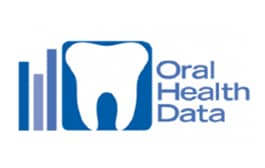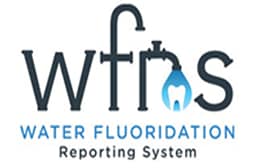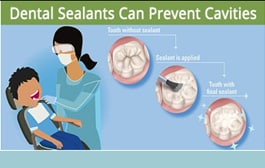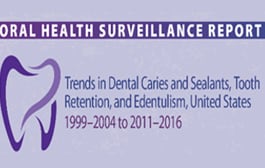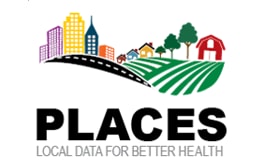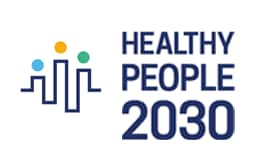Indicator Definitions – Oral Health
Oral health is the health of the teeth, gums, mouth, and the entire oral-facial system. Oral health is integral to overall health and plays a critical role in physical, mental, social and economic well-being. Oral diseases and conditions are among the most prevalent diseases in the United States, ranging from dental caries (i.e., tooth decay or cavities) and periodontal (i.e., gum) disease to tooth loss and oral cancers. Nearly all Americans have had tooth decay in their lifetime, and 42% of US adults 30 years or older, who had not lost all of their teeth, had periodontal disease in 2009-2014. Oral diseases, left untreated, can cause severe pain, infections, and tooth loss and in rare cases, death. These detrimental outcomes can significantly impact ability to eat, learn, and work, reducing overall quality of life. Poor oral health is associated with other chronic diseases, such as diabetes and heart disease. Despite significant improvements in the nation’s oral health in past decades, profound disparities remain. Poor oral health disproportionately affects populations with low socioeconomic status as well as racial and ethnic minority populations.

Most oral diseases are largely preventable. Public health strategies such as community water fluoridation and school sealant programs are evidence-based, safe, and cost-effective measures to prevent cavities and improve oral health equity. Many oral diseases share modifiable risk factors (e.g., tobacco use, alcohol use, and consumption of sugary foods and beverages) with other leading chronic diseases (e.g., type 2 diabetes, cancer). Regular access to oral health care facilities and resources is critical for receiving prevention services and early treatment. Unfortunately, cost and lack of dental insurance are still prominent barriers to access to oral health care resources. Among medical care, prescription drugs, and dental care, dental care is the most prevalent unmet health care due to cost. Healthy People 2030 selected increasing use of oral health care across the life span as a Leading Health Indicator, representing a high-priority objective of the nation. Promoting medical-dental integration at levels of health care systems, public health programs and policies are key strategies to further improve oral health.
| Visit Oral Health | CDC for more information about oral health. |
Definition Details
| Population: | Adults aged 18–64 |
| Numerator: | Adults aged 18–64 years who report having no permanent tooth extracted due to tooth decay or gum disease. |
| Denominator: | Adults aged 18–64. |
| Measure: | Prevalence (crude and age-adjusted) |
| Time Period of Case Definition: | Lifetime |
| Summary: | In 2020, among the 50 states and DC, the median prevalence of adults aged 18–64 years who had no permanent tooth extracted due to tooth decay or gum diseases was 67.1%, gradually increasing from 62.5% in 2012.1 Despite improvement in tooth retention in US adults over the past decades, disparities remain across some population groups, such as lower number of teeth retained in adults who were non-Hispanic Black, with lower income and lower educational level, and current smokers.2 Tooth loss affects a person’s ability to chew and speak and can interfere with social functioning.3 The most common causes of tooth loss in adults are dental caries (tooth decay) and periodontal (gum) disease.4 Personal, professional, and population-based strategies to prevent and control gum disease and tooth decay can help ensure tooth retention throughout life.4,5 |
| Notes: | Questions are part of the rotating core, currently collected in even years. |
| Data Source: | Behavioral Risk Factor Surveillance System (BRFSS) |
| Related Objectives or Recommendations: | Healthy People 2030 objective: OH-05. Reduce the proportion of adults aged 45 years and over who have lost all their teeth |
| Related CDI Topic Area: | None |
| Reference 1: | Centers for Disease Control and Prevention. Chronic Disease Indicators (CDI) Data. Centers for Disease Control and Prevention; 2022. https://nccd.cdc.gov/cdi |
| Reference 2: | Centers for Disease Control and Prevention, Division of Oral Health. Oral Health Surveillance Report: Trends in Dental Caries and Sealants, Tooth Retention, and Edentulism, United States, 1999–2004 to 2011–2016. Centers for Disease Control and Prevention; 2019. https://www.cdc.gov/oralhealth/publications/OHSR-2019-index.html |
| Reference 3: | Griffin SO, Jones JA, Brunson D, Griffin PM, Bailey WD. Burden of oral disease among older adults and implications for public health priorities. Am J Public Health. 2012;102(3):411-418. doi:10.2105/AJPH.2011.300362 |
| Reference 4: | Centers for Disease Control and Prevention, Division of Oral Health. Oral Health Conditions. Centers for Disease Control and Prevention; 2022. https://www.cdc.gov/oralhealth/conditions |
| Reference 5: | National Institutes of Health. Oral Health in America: Advances and Challenges. US Department of Health and Human Services, National Institutes of Health, National Institute of Dental and Craniofacial Research; 2021. https://www.ncbi.nlm.nih.gov/pubmed/35020293 |
| Population: | Adults aged 65 years and older |
| Numerator: | Adults aged 65 years and older who report having lost six or more natural teeth due to tooth decay or gum disease. |
| Denominator: | Adults aged 65 years and older. |
| Measure: | Prevalence (crude and age-adjusted) |
| Time Period of Case Definition: | Lifetime |
| Summary: | Estimates from the 2020 Behavioral Risk Factor Surveillance System (BRFSS) indicated 33.0% of US adults aged ≥ 65 years had lost six or more teeth, decreasing from 39.6% in 2012.1 Despite improvement in tooth retention, disparities in tooth loss by race and ethnicity, education level, income, and smoking status remain.1, 2 Dental caries (tooth decay or cavities) and periodontal (gum) disease are leading causes of tooth loss. Because having ≥20 teeth is necessary for functional dentition, even partial tooth loss can compromise person’s essential chewing and speech functions and diminish quality of life.3 Older adults with selected chronic conditions (e.g., diabetes and heart disease) had significantly higher prevalence of severe or complete tooth loss than those without the condition.4Personal, professional, and population-based strategies to prevent and control gum disease and tooth decay can help prevent tooth loss.5, 6 |
| Notes: | Questions are part of the rotating core, currently collected in even years. |
| Data Source: | Behavioral Risk Factor Surveillance System (BRFSS) |
| Related Objectives or Recommendations: | Healthy People 2030 objective: OH-05. Reduce the proportion of adults aged 45 years and over who have lost all their teeth |
| Related CDI Topic Area: | Older Adults |
| Reference 1: | Centers for Disease Control and Prevention, Division of Oral Health. Oral Health Data. Centers for Disease Control and Prvention; 2020. https://www.cdc.gov/oralhealthdata/. |
| Reference 2: | Centers for Disease Control and Prevention, Division of Oral Health. Oral Health Surveillance Report: Trends in Dental Caries and Sealants, Tooth Retention, and Edentulism, United States, 1999–2004 to 2011–2016. Centers for Disease Control and Prevention; 2019. https://www.cdc.gov/oralhealth/publications/OHSR-2019-index.html |
| Reference 3: | Griffin SO, Jones JA, Brunson D, Griffin PM, Bailey WD. Burden of oral disease among older adults and implications for public health priorities. Am J Public Health. 2012;102(3):411-418. doi:10.2105/AJPH.2011.300362 |
| Reference 4: | Parker ML, Thornton-Evans G, Wei L, Griffin SO. Prevalence of and changes in tooth loss among adults aged ≥50 years with selected chronic conditions — United States, 1999–2004 and 2011–2016. MMWR Morb Mortal Wkly Rep. 2020;69(21):641-6. |
| Reference 5: | Centers for Disease Control and Prevention, Division of Oral Health. Oral Health Conditions. Centers for Disease Control and Prevention; 2022. https://www.cdc.gov/oralhealth/conditions |
| Reference 6: | National Institutes of Health. Oral Health in America: Advances and Challenges. US Department of Health and Human Services, National Institutes of Health, National Institute of Dental and Craniofacial Research; 2021. https://www.ncbi.nlm.nih.gov/pubmed/35020293 |
| Population: | Adults aged 65 years and older |
| Numerator: | Adults aged 65 years and older who report having lost all of their natural teeth due to tooth decay or gum disease |
| Denominator: | Adults aged 65 years and older. |
| Measure: | Prevalence (crude and age-adjusted) |
| Time Period of Case Definition: | Lifetime |
| Summary: | Estimates from the Behavioral Risk Factor Surveillance System (BRFSS) indicated the prevalence of edentulism (i.e., having lost all natural teeth or complete tooth loss) among US adults aged ≥ 65 years decreased from 16.2% in 2012 to 13.8% in 2020.1 Despite improvement in tooth retention over the past decades, disparities remain across some populations, such as higher prevalence of edentulism in adults with lower income and lower educational level, and current smokers.2 Dental caries (tooth decay or cavities) and periodontal (gum) disease are leading causes of tooth loss. Complete tooth loss substantially limit food choices and eating and chewing ability, and affect quality of life.3 Older adults with chronic conditions (e.g., diabetes and heart disease) had significantly higher prevalence of severe and complete tooth loss than those without the condition.4 Personal, professional, and population-based strategies to prevent and control gum disease and tooth decay can help ensure tooth retention.5, 6 |
| Notes: | Questions are part of the rotating core, currently collected in even years. |
| Data Source: | Behavioral Risk Factor Surveillance System (BRFSS) |
| Related Objectives or Recommendations: | Healthy People 2030 objective: OH-05. Reduce the proportion of adults aged 45 years and over who have lost all their teeth. |
| Related CDI Topic Area: | Older Adults |
| Reference 1: | Centers for Disease Control and Prevention, Division of Oral Health. Oral Health Data. Centers for Disease Control and Prevention; 2020. https://www.cdc.gov/oralhealthdata/ |
| Reference 2: | Centers for Disease Control and Prevention, Division of Oral Health. Oral Health Surveillance Report: Trends in Dental Caries and Sealants, Tooth Retention, and Edentulism, United States, 1999–2004 to 2011–2016. Centers for Disease Control and Prevention; 2019. https://www.cdc.gov/oralhealth/publications/OHSR-2019-index.html |
| Reference 3: | Griffin SO, Jones JA, Brunson D, Griffin PM, Bailey WD. Burden of oral disease among older adults and implications for public health priorities. Am J Public Health. 2012;102(3):411-8. |
| Reference 4: | Parker ML, Thornton-Evans G, Wei L, Griffin SO. Prevalence of and changes in tooth loss among adults aged ≥50 years with selected chronic conditions — United States, 1999–2004 and 2011–2016. MMWR Morb Mortal Wkly Rep. 2020;69(21):641-6. |
| Reference 5: | Centers for Disease Control and Prevention, Division of Oral Health. Oral Health Conditions. Centers for Disease Control and Prevention; 2022. https://www.cdc.gov/oralhealth/conditions |
| Reference 6: | National Institutes of Health. Oral Health in America: Advances and Challenges. US Department of Health and Human Services, National Institutes of Health, National Institute of Dental and Craniofacial Research; 2021. https://www.ncbi.nlm.nih.gov/pubmed/35020293 |
| Population: | Children and adolescents aged 1–17 years |
| Numerator: | Children and adolescents aged 1–17 years with parent-reported dental visit to a dentist or other oral health care provider for any kind of dental or oral health care in the past year. |
| Denominator: | Children and adolescents aged 1–17 years. |
| Measure: | Prevalence (crude) from a 2-year cycle |
| Time Period of Case Definition: | In the past 12 months |
| Summary: | Estimates from the 2020–2021 National Survey of Children’s Health indicated 75.1% of children aged 1–17 years had a past-year dental visit.1 Routine dental visits allow for oral health education, preventive services (e.g., sealants, fluoride varnish), and early detection and treatment of oral diseases such as dental caries (cavities).2-4 Untreated cavities can lead to pain, infection, and costly treatment. Approximately 34 million school hours were lost annually due to unplanned and acute dental treatment in 2008.5 The American Academy of Pediatric Dentistry recommends children have their first dental visit at the time the first tooth erupts, and at least by age one.6 Lack of dental use and poor oral health disproportionately affect low socioeconomic status and racial or ethnic minority populations.2,7 Increasing use of oral health care is a Healthy People 2030 Leading Health Indicator, representing a high-priority objective to reduce health disparities and improve oral health of the nation.8 |
| Notes: | Oral health literacy, social determinants of health, and access to care may affect dental visits.3 The indicator does not validate types of dental care children actually received. |
| Data Source: | National Survey of Children’s Health (NSCH) |
| Related Objectives or Recommendations: | Healthy People 2030 objective(s): OH-08. Increase use of oral health care system; OH-09. Increase the proportion of low-income youth who have a preventive dental visit |
| Related CDI Topic Area: | School Health |
| Reference 1: | Child and Adolescent Health Mesaurement Initiative. 2020–2021 National Survey of Children’s Health (NSCH) Data Query. Data Resource Center for Child and Adolescent Health supported by the Health Resources and Services Administration (HRSA). https://www.childhealthdata.org/browse/survey |
| Reference 2: | National Institutes of Health. Oral Health in America: Advances and Challenges. US Department of Health and Human Services, National Institutes of Health, National Institute of Dental and Craniofacial Research; 2021. https://www.ncbi.nlm.nih.gov/pubmed/35020293 |
| Reference 3: | Institute of Medicine and National Research Council. Improving Access to Oral Health Care for Vulnerable and Underserved Populations. Institute of Medicine and National Research Council; 2011. https://www.hrsa.gov/sites/default/files/publichealth/clinical/oralhealth/improvingaccess.pdf |
| Reference 4: | American Academy of Pediatric Dentistry. Periodicity of Examination, Preventive Dental Services, Anticipatory Guidance/Counseling, and Oral Treatment for Infants, Children, and Adolescents. Pediatr Dent. 2017;39(6):188-196. |
| Reference 5: | Naavaal S, Kelekar U. School hours lost due to acute/unplanned dental care. Health Behav Policy Rev. 2018;5(2):66-73. |
| Reference 6: | American Academy of Pediatric Dentistry. Periodicity of Examination, Preventive Dental Services, Anticipatory Guidance/Counseling, and Oral Treatment for Infants, Children, and Adolescents. The Reference Manual of Pediatric Dentistry. Chicago, Ill.: American Academy of Pediatric Dentistry; 2022:253-65 https://www.aapd.org/globalassets/media/policies_guidelines/bp_periodicity.pdf |
| Reference 7: | Centers for Disease Control and Prevention, Division of Oral Health. Oral Health Surveillance Report: Trends in Dental Caries and Sealants, Tooth Retention, and Edentulism, United States, 1999–2004 to 2011–2016. Centers for Disease Control and Prevention; 2019. https://www.cdc.gov/oralhealth/publications/OHSR-2019-index.html |
| Reference 8: | US Department of Health and Human Services. Healthy People 2030, Leading Health Indicators 2020. US Department of Health and Human Services; 2020. https://health.gov/healthypeople/objectives-and-data/leading-health-indicators |
| Population: | Children and adolescents aged 1–17 years |
| Numerator: | Children and adolescents aged 1–17 years with parent-reported preventive dental visit, including receipt of dental sealants or fluoride treatment, in the past year. |
| Denominator: | Children and adolescents aged 1–17 years. |
| Measure: | Prevalence (crude) from a 2-year cycle |
| Time Period of Case Definition: | In the past 12 months |
| Summary: | Tooth decay is among the greatest unmet treatment needs in US youth.1 During 2011–2016, more than half of US youth experienced caries.2 Untreated caries can lead to severe pain, infections, costly treatment, and problems with eating, speaking, and learning.1 Dental sealants and topical fluoride (e.g., fluoride varnish)—evidence-based caries preventive measures—are recommended and supported by major clinical and public health organizations and agencies to improve oral health and health equity among children.1, 3-6 Estimates from the National Survey of Children’s Health (NSCH) 2020–2021 indicated receipt of sealants (14.0%) and fluoride treatment (42.4%) among US youth was much lower than receipt of any preventive dental services (75.1%), and presented pronounced disparities by sociodemographic characteristics (e.g., race and ethnicity, family income, health insurance status).7 |
| Notes: | Oral health literacy, social determinants of health, and access to care may affect dental visits.8 The indicator is based on parent report and does not validate types of dental care children actually received. |
| Data Source: | National Survey of Children’s Health (NSCH) |
| Related Objectives or Recommendations: | Healthy People 2030 objective: OH-09. Increase the proportion of low-income youth who have a preventive dental visit |
| Related CDI Topic Area: | School Health |
| Reference 1: | Griffin SO, Wei L, Gooch BF, Weno K, Espinoza L. Vital Signs: dental sealant use and untreated tooth decay among U.S. school-aged children. MMWR Morb Mortal Wkly Rep. 2016;65(41):1141-5. |
| Reference 2: | Centers for Disease Control and Prevention, Division of Oral Health. Oral Health Surveillance Report: Trends in Dental Caries and Sealants, Tooth Retention, and Edentulism, United States, 1999–2004 to 2011–2016. Centers for Disease Control and Prevention; 2019. https://www.cdc.gov/oralhealth/publications/OHSR-2019-index.html |
| Reference 3: | Weyant RJ, Tracy SL, Anselmo TT, et al. Topical fluoride for caries prevention: executive summary of the updated clinical recommendations and supporting systematic review. J Am Dent Assoc. 2013;144(11):1279-91. |
| Reference 4: | US Preventive Services Task Force. Prevention of Dental Caries in Children Younger Than 5 Years: Screening and Interventions 2021. USPSTF; 2021. https://uspreventiveservicestaskforce.org/uspstf/recommendation/prevention-of-dental-caries-in-children-younger-than-age-5-years-screening-and-interventions1 |
| Reference 5: | Community Preventive Services Task Force, The Community Guide. Dental Caries (Cavities): School-Based Dental Sealant Delivery Programs 2013. Community Preventive Services Task Force; 2021. https://www.thecommunityguide.org/findings/dental-caries-cavities-school-based-dental-sealant-delivery-programs |
| Reference 6: | Centers for Medicare and Medicaid Services. Core Set of Children’s Health Care Quality Measures 2022. Centers for Medicare and Medicaid Services; 2023. https://www.medicaid.gov/medicaid/quality-of-care/performance-measurement/adult-and-child-health-care-quality-measures/childrens-health-care-quality-measures/index.html |
| Reference 7: | Child and Adolescent Health Mesaurement Initiative. 2020–2021 National Survey of Children’s Health (NSCH) Data Query. Data Resource Center for Child and Adolescent Health supported by the Health Resources and Services Administration (HRSA). https://www.childhealthdata.org/browse/survey |
| Reference 8: | Institute of Medicine and National Research Council. Improving Access to Oral Health Care for Vulnerable and Underserved Populations. Institute of Medicine and National Research Council; 2011. https://www.hrsa.gov/sites/default/files/publichealth/clinical/oralhealth/improvingaccess.pdf |
| Population: | All adults |
| Numerator: | Adults who report having been to the dentist or dental clinic in the past year |
| Denominator: | All adults. |
| Measure: | Prevalence (crude and age-adjusted) |
| Time Period of Case Definition: | In the past year |
| Summary: | Routine dental visits allow for oral health education, preventive care services, early detection and treatment of oral diseases such as dental caries (cavities), periodontal (gum) disease, and oral cancer.1, 2 Estimates from the 2020 Behavioral Risk Factor Surveillance System (BRFSS) indicated 64.8% of adults aged ≥18 years reported having a past-year dental visit.3 In2014, adults reported financial barriers to accessing dental care (12.8%) three times more frequently than children and adolescents (4.3%).4 Studies found lower dental use among adults with lower income, less education, no health care coverage, and adults who were non-Hispanic Black, smoked, had dental or other chronic diseases, or lived in rural areas.1-2, 5-6 Increasing use of the oral health care system is a Healthy People 2030 Leading Health Indicator, representing a high priority objective to reduce health disparities and improve oral health of the nation.7 |
| Notes: | This indicator does not convey reasons for dental visit and is self-reported. Questions are part of the rotating core, currently collected in even years. |
| Data Source: | Behavioral Risk Factor Surveillance System (BRFSS) |
| Related Objectives or Recommendations: | Healthy People 2030 objective: OH-08. Increase use of oral health care system |
| Related CDI Topic Area: | None |
| Reference 1: | National Institutes of Health. Oral Health in America: Advances and Challenges. US Department of Health and Human Services, National Institutes of Health, National Institute of Dental and Craniofacial Research; 2021. https://www.ncbi.nlm.nih.gov/pubmed/35020293 |
| Reference 2: | Institute of Medicine and National Research Council. Improving Access to Oral Health Care for Vulnerable and Underserved Populations. Institute of Medicine and National Research Council; 2011. https://www.hrsa.gov/sites/default/files/publichealth/clinical/oralhealth/improvingaccess.pdf |
| Reference 3: | Centers for Disease Control and Prevention, Division of Oral Health. Oral Health Data. Centers for Disease Control and Prvention; 2020. https://www.cdc.gov/oralhealthdata/ |
| Reference 4: | Vujicic M, Buchmueller T, Klein R. Dental care presents the highest level of financial barriers, compared to other types of health care services. Health Aff (Millwood). 2016;35(12):2176-82. |
| Reference 5: | Patel N, Fils-Aime R, Li CH, Lin M, Robison V. Prevalence of past-year dental visit among US adults aged 50 years or older, with selected chronic diseases, 2018. Prev Chronic Dis. 2021;18:E40. |
| Reference 6: | Eke PI, Thornton-Evans GO, Wei L, Borgnakke WS, Dye BA, Genco RJ. Periodontitis in US adults: national health and nutrition examination survey 2009-2014. J Am Dent Assoc. 2018;149(7):576-88 e6. |
| Reference 7: | US Department of Health and Human Services. Healthy People 2030, Leading Health Indicators 2020. US Department of Health and Human Services; 2020. https://health.gov/healthypeople/objectives-and-data/leading-health-indicators |
| Population: | Women who have had a recent live birth |
| Numerator: | Women who reported that they had their teeth cleaned by a dentist or dental hygienist in the 12 months before their most recent pregnancy. |
| Denominator: | Women who did not have a health care visit in the 12 months before pregnancy, or who had a health care visit in the 12 months before their most recent pregnancy and reported that they did or did not have their teeth cleaned by a dentist or dental hygienist. |
| Measure: | Prevalence (crude) |
| Time Period of Case Definition: | During the 12 months before the pregnancy resulting in the most recent live birth |
| Summary: | Physiologic and behavioral changes during pregnancy may impact women’s oral health.1 Routine dental care before, during, and after pregnancy is essential for women to receive oral health education and preventive and treatment services, and thereby promote healthy pregnancy, and oral and overall health of mothers and children.1,2 The American Academy of Periodontology recommends periodontal evaluation and treatment and good oral hygiene for women before and during pregnancy.3 In 2020, among women with a recent live birth in 42 PRAMS participating jurisdictions, the overall prevalence of having a teeth cleaning in the 12 months before pregnancy was 41.9%.4 Lower dental use before and during pregnancy was reported among racial and ethnic minority women and women without dental insurance.5,6 Improving dental use for women around pregnancy requires interprofessional collaboration among obstetric, oral health, and other health professionals.8 |
| Notes: | None |
| Data Source: | Pregnancy Risk Assessment Monitoring System (PRAMS) |
| Related Objectives or Recommendations: | Healthy People 2030 objective: OH-08. Increase proportion of children, adolescents, and adults who use the oral health care system |
| Related CDI Topic Area: | Maternal Health |
| Reference 1: | American College of Obstetricians and Gynecologists, Committee on Health Care for Underserved Women. Committee Opinion No. 569: oral health care during pregnancy and through the lifespan (Reconfirmed 2017). Obstet Gynecol. 2013;122(2):417-22. |
| Reference 2: | Johnson K, Posner SF, Biermann J, et al. Recommendations to improve preconception health and health care — United States. A report of the CDC/ATSDR Preconception Care Work Group and the Select Panel on Preconception Care. MMWR Recomm Rep. 2006;55(Rr-6):1-23. |
| Reference 3: | American Academy of Periodontology. American Academy of Periodontology statement regarding periodontal management of the pregnant patient. J Periodontol. 2004;75(3):495. |
| Reference 4: | Centers for Disease Control and Prevention. Chronic Disease Indicators (CDI) Data. Centers for Disease Control and Prevention; 2022. https://nccd.cdc.gov/cdi |
| Reference 5: | Robison V, Bauman B, D’Angelo DV, Espinoza L, Thornton-Evans G, Lin M. The impact of dental insurance and medical insurance on dental care utilization during pregnancy. Matern Child Health J. 2021;25(5):832-40. |
| Reference 6: | Robbins CL, Zapata LB, Farr SL, et al. Core state preconception health indicators — Pregnancy Risk Assessment Monitoring System and Behavioral Risk Factor Surveillance System, 2009. MMWR Surveill Summ. 2014;63(3):1-62. |
| Reference 7: | American Public Health Association. Policy Statement: Improving Access to Dental Care for Pregnant Women through Education, Integration of Health Services, Insurance Coverage, an Appropriate Dental Workforce, and Research 2020. American Public Health Association; 2020. https://www.apha.org/policies-and-advocacy/public-health-policy-statements/policy-database/2021/01/12/improving-access-to-dental-care-for-pregnant-women |
